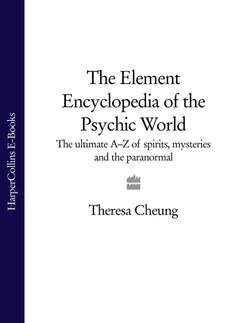Читать книгу The Element Encyclopedia of the Psychic World: The Ultimate A–Z of Spirits, Mysteries and the Paranormal - Theresa Cheung, Theresa Cheung - Страница 79
AUTOMATIC WRITING
ОглавлениеThe most common form of automatism, automatic writing is writing that does not come from the conscious mind and is done in an altered state of consciousness. Some attribute it to spiritual beings who are somehow able to manipulate a writing utensil in order to communicate. Psychical researchers believe automatic writing emanates from material in the person’s subconscious mind or is obtained through ESP.
Many people try automatic writing in an effort to make contact with spirits or to communicate with the dead. Typically the writer is unaware of what is being written and the writing is much faster, larger and expansive than their normal handwriting. Some people experience tingling in the arms or hands. Pens are a common tool, but slates and typewriters may also be used. Automatic writers have been known to produce mirror scripts, starting at the bottom right of the page and finishing at the top left. At the height of spiritualism, automatic writing was common in séances, and it replaced the much slower methods of spelling out messages from spirits with table rappings or pointers.
In some cases automatic writing occurs involuntarily, as in the case of Anna Windsor. In 1860 Windsor began automatic writing with her right hand, which she called Stump. Stump had a personality of its own, writing out verses and prose while the left hand did something else.
Through automatic writing, mediums have claimed to produce messages not just from deceased relatives or loved ones but from famous persons in history, such as Francis Bacon, Emanuel Swedenborg and even Jesus Christ. Frederick Myers, one of the founders of the Society for Psychical Research, found little evidence that spirits communicated through automatic writing but, curiously, after his death several mediums claimed to receive automatic writing messages from him.
Exercise to practise automatic writing
Make sure you are in a calm and relaxed mood. If you feel stressed or anxious, leave it and try another day.
Find a good pen or pencil and a quiet place at a table. Sit there and let your hand move as it will. You may like to ask your hand if it has any messages for you. Hold your pen loosely in whichever hand you normally write with and let your mind roam freely. Write down whatever comes into your head for about five to ten minutes at the most.
If nothing happens, visualize a column of light made up of golden letters, forming and reforming words. Focus on one letter, and let the light flow down into your fingers and the pen. Wait until you feel your pen tremble, and let it move. At first it may scribble and make patterns, but words may follow. Don’t try to read or make sense of them or you will lose the spontaneity.
When you feel you are losing concentration, stop. Lay your pen down and see the column of light fading. Read what you have written. It may seem to relate to you or to another person in your life, perhaps a persona that is deep within you. Don’t be concerned if your first attempts appear nothing more than random scribbles or a jumble of disconnected words. It takes practise to establish a clear delivery of information.
Do something mundane or physical to bring you back to earth.
While psychical researchers continue to investigate automatic writing as evidence for the existence of the spirit world, the field of psychology has adopted automatic writing. Psychologists use it as a way for the unconscious mind to express thoughts and feelings that cannot be verbalized. Automatic writing continues to be used as a therapeutic tool to this day. Some critics warn of dangers in automatic writing -they claim that the writer is vulnerable to harassment from the evil-minded dead. However, psychologists maintain that the real danger is in exposing material from the unconscious that has been repressed.
